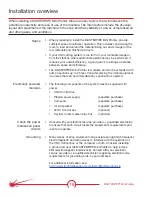
5
Safety Guide
4.4
Be sure there are no combustible or flammable materials in the
workplace. Any material that cannot be removed must be protected.
4.4.1
Sparks and hot materials from cutting or gouging can easily
go through small cracks and openings to adjacent areas.
4.4.2
Avoid cutting or gouging near hydraulic lines.
4.4.3
Do not cut or gouge tanks, drums or containers until the
proper steps have been taken to insure that such procedures
will not cause flammable or toxic vapors from substances
inside. They can cause an explosion even though they have
been “cleaned.” For information purchase “Recommended
Safe Practices for the Preparation for Welding and Cutting
of Containers and Piping That Have Held Hazardous
Substances”, AWS F4.1 from the American Welding Society
(see address above).
4.4.4
Vent hollow castings or containers before heating, cutting or
gouging. They may explode.
4.5
Do not add fuel to engine driven equipment near an area where
plasma cutting or gouging is being done.
4.6
Connect the work cable to the work as close to the cutting or
gouging area as practical. Work cables connected to the building
framework or other locations away from the cutting or gouging area
increase the possibility of the current passing through lifting chains,
crane cables or other alternate circuits. This can create fire hazards
or overheat lifting chains or cables until they fail.
4.7
Hydrogen gas may be formed and trapped under aluminum work
pieces when they are cut underwater or while using a water table.
DO NOT cut aluminum alloys underwater or on a water table
unless the hydrogen gas can be eliminated or dissipated. Trapped
hydrogen gas that is ignited will cause an explosion.
4.8
Read and follow NFPA 51B “ Standard for Prevention During
Welding, Cutting and Other Hot Work”, available from NFPA, 1
Batterymarch Park,PO box 9101, Quincy, Ma 022690-9101.
5.
CYLINDER may EXPLODE if damaged.
5.1
Use only compressed gas cylinders containing the correct gas for
the process used and properly operating regulators designed for the
gas and pressure used. All hoses, fittings, etc., should be suitable
for the application and maintained in good condition.
5.2
Always keep cylinders in an upright position securely chained to an
undercarriage or fixed support.
5.3
Cylinders should be located: • Away from areas where they may
be struck or subjected to physical damage. • A safe distance from
plasma cutting or gouging, arc welding operations and any other
source of heat, sparks, or flame.
5.4
Never allow any part of the electrode, torch or any other electrically
“hot” parts to touch a cylinder.
5.5
Keep your head and face away from the cylinder valve outlet when
opening the cylinder valve.
5.6
Valve protection caps should always be in place and hand tight
except when the cylinder is in use or connected for use.
Cylinder Explosion
Summary of Contents for MASTERPIPE Mini Profiler
Page 9: ...1 Safety Guide Safety Information ...
Page 19: ...11 Installation and Operations Guide Hardware Installation ...
Page 62: ...54 MASTERPIPE Mini Profiler ...
Page 63: ...55 Driver Software Driver Introduction ...
Page 65: ...57 Driver Software Illustrations screen shots of the TM4 installation pro cess ...
Page 67: ...59 Driver Software Illustrations screen shots of the device driver installa tion process ...
Page 96: ...88 MASTERPIPE Mini Profiler ...
Page 97: ...89 Installation and Operations Guide Parts ...
Page 100: ...92 MASTERPIPE Mini Profiler ...
Page 101: ...93 Installation and Operations Guide Troubleshooting ...














































